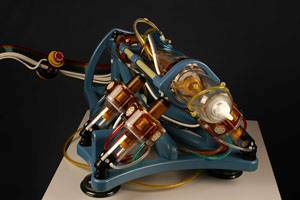| Urology, surgery | |
Metal-free motor makes robotic biopsies safe for use with MRI17 April 2007 Engineers at the Johns Hopkins Urology Robotics Lab have developed a motor without metal or electricity that can safely power remote-controlled robotic surgical tools used for cancer biopsies and therapies guided by magnetic resonance imaging. The motor that drives the devices can be so precisely controlled by computer that movements are steadier and more precise than a human hand. The motor is constructed of nonmagnetic and dielectric materials such as plastics, ceramics, and rubbers and is electricity free. It is driven by compressed air and fibre optic technology is used for communications, so that all electric components are located away from the MRI scanner. Six of the motors are used in a surgical robot designed to carry out precise MRI-guided surgical procedures (see below).
“Lots of biopsies on organs such as the prostate are currently performed blind because the tumours are typically invisible to the imaging tools commonly used,” says Dan Stoianovici, Ph.D., an associate professor of urology at Johns Hopkins and director of the robotics lab. “Our new MRI-safe motor and robot can target the tumours. This should increase accuracy in locating and collecting tissue samples, reduce diagnostic errors and also improve therapy. Prostate cancer is tricky because it only can be seen under MRI, and in early stages it can be quite small and easy to miss.” A report on the new motor was published in the February issue of the IEEE/ASME Transactions on Mechanotronics. The challenge for his engineering team was to overcome MRI’s dependence on strong magnetic interference. Metals are unsafe in MRIs because the machine relies on a strong magnet, and electric currents distort MR images, says Stoianovici. The new motor, dubbed PneuStep, consists of three pistons connected to a series of gears. The gears are turned by air flow, which is in turn controlled by a computer located in a room adjacent to the MRI machine. “We’re able to achieve precise and smooth motion of the motor as fine as 50 micrometers, finer than a human hair,” says Stoianovici. The robot currently is undergoing preclinical testing. The robot goes alongside the patient in the MRI scanner and is controlled remotely by observing the images on the MR. The motor is rigged with fibre optics, which feeds information back to the computer in real time, allowing for both guidance and readjustment. “The robot moves slowly but precisely, and our experiments show that the needle always comes within a millimetre of the target,” says Stoianovici. This type of precision control will allow physicians to use instruments in ways that currently are not possible, he says. “This remarkable robot has a lot of promise — the wave of the future is image-guided surgery to better target, diagnose and treat cancers with minimally invasive techniques,” says Li-Ming Su, M.D., an associate professor of urology and director of laparoscopic and robotic urologic surgery at the Brady Urological Institute at Hopkins.
|
